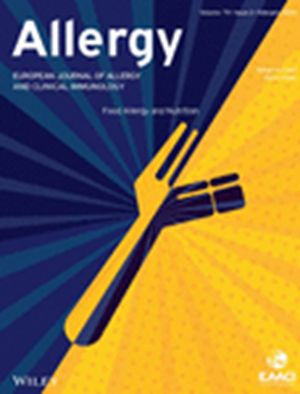微环境驱动的肥大细胞可塑性:皮肤和呼吸疾病中细胞因子激活基因特征的见解。
IF 12
1区 医学
Q1 ALLERGY
引用次数: 0
摘要
肥大细胞(MCs)由于大量细胞因子受体的表达而迅速适应微环境。了解微环境引发的免疫反应对于阐明MCs经历的表型/功能变化至关重要,从而了解它们对疾病的贡献并预测最有效的治疗策略。我们将原代人MCs暴露于模拟T1/促炎(IFNγ)、T2/过敏(IL-4 + IL-13)、富含报警蛋白(IL-33)和促纤维化/促耐受性(TGFβ)微环境的细胞因子中。我们研究了MC表面受体的表达、激活、细胞因子、组胺和前列腺素D2的释放,并通过转录组学来定义共同的和独特的遗传特征。利用机器学习,我们提取了最小的细胞因子激活特征,并对皮肤和呼吸系统疾病的组织MCs进行了基因集变异分析(GSVA)、单细胞聚类和伪时间分析。体外暴露于IFNγ的MCs获得抗原呈递表型(HLA-DR+),增加ige介导的应答和组胺释放,而TGFβ抑制活化并提高整合素αvβ3的表达。IL-33主要驱动细胞因子(GM-CSF, IL-5, IL-10, IL-13)和趋化因子(IL-8, MCP-1, MIP-1α)的产生,并促进混合IgG-IgE反应。在唯一表达的基因中,245个基因对鉴别细胞因子引发的MCs具有很高的信息性。GSVA显示,MC IL-4 + IL-13在特应性皮炎和银屑病中富集,IFNγ在COVID-19感染和囊性纤维化中富集,IL-33在COVID-19和慢性阻塞性肺疾病(COPD)中富集,TGFβ在肺纤维化(PF)和慢性鼻窦炎中富集。此外,我们在嗜酸性粒细胞高的COPD中检测到IL-33/TGFβ阳性。最小细胞因子激活特征鉴定了疾病细胞因子特异性MC簇和假时间轨迹,表明MCs参与纤维化(COPD/PF), T1/警报驱动的炎症(COVID-19)和混合T1/T2炎症反应(AD/牛皮癣)。总之,在细胞因子驱动的环境中,MCs具有表型和功能多样性。因此,独特的MC特征将有助于识别细胞因子引发的MC,并预测抗细胞因子治疗MC驱动疾病的疗效。本文章由计算机程序翻译,如有差异,请以英文原文为准。
Microenvironment-Driven Mast Cell Plasticity: Insights From Cytokine-Activated Gene Signatures in Skin and Respiratory Diseases.
Mast cells (MCs) rapidly adapt to the microenvironment due to the plethora of cytokine receptors expressed. Understanding microenvironment-primed immune responses is essential to elucidate the phenotypic/functional changes MCs undergo, and thus understand their contribution to diseases and predict the most effective therapeutic strategies. We exposed primary human MCs to cytokines mimicking a T1/pro-inflammatory (IFNγ), T2/allergic (IL-4 + IL-13), alarmin-rich (IL-33) and pro-fibrotic/pro-tolerogenic (TGFβ) microenvironment. We investigated MC surface receptor expression, activation, cytokine, histamine, and prostaglandin D2 release, and performed transcriptomics to define shared and unique genetic features. Using machine learning, we extracted minimal cytokine-activated signatures and performed gene set variation analysis (GSVA), single-cell clustering, and pseudotime analyses on tissue MCs from skin and respiratory diseases. MCs exposed in vitro to IFNγ acquire an antigen-presenting phenotype (HLA-DR+), increase IgE-mediated responses and histamine release, while TGFβ inhibits activation and boosts integrin αvβ3 expression. IL-33 primarily drives cytokine (GM-CSF, IL-5, IL-10, IL-13) and chemokine production (IL-8, MCP-1, MIP-1α) and facilitates mixed IgG-IgE responses. Among uniquely expressed genes, 245 were highly informative to discriminate cytokine-primed MCs. GSVA revealed MC IL-4 + IL-13 signatures enriched in atopic dermatitis and psoriasis, IFNγ in COVID-19 infection and cystic fibrosis, IL-33 in COVID-19 and chronic obstructive pulmonary disease (COPD) and TGFβ in pulmonary fibrosis (PF) and chronic rhinosinusitis. Furthermore, we detected positive IL-33/TGFβ priming in eosinophil-high COPD. Minimal cytokine-activated signatures identified disease-cytokine-specific MC clusters and pseudotime trajectories, suggesting involvement of MCs in fibrosis (COPD/PF), T1/alarmin-driven inflammation (COVID-19) and mixed T1/T2 inflammatory responses (AD/psoriasis). In conclusion, in cytokine-driven settings, MCs are phenotypically and functionally diverse. Thus, unique MC signatures will help to identify cytokine-primed MCs and predict the efficacy of anti-cytokine treatment in MC-driven diseases.
求助全文
通过发布文献求助,成功后即可免费获取论文全文。
去求助
来源期刊

Allergy
医学-过敏
CiteScore
26.10
自引率
9.70%
发文量
393
审稿时长
2 months
期刊介绍:
Allergy is an international and multidisciplinary journal that aims to advance, impact, and communicate all aspects of the discipline of Allergy/Immunology. It publishes original articles, reviews, position papers, guidelines, editorials, news and commentaries, letters to the editors, and correspondences. The journal accepts articles based on their scientific merit and quality.
Allergy seeks to maintain contact between basic and clinical Allergy/Immunology and encourages contributions from contributors and readers from all countries. In addition to its publication, Allergy also provides abstracting and indexing information. Some of the databases that include Allergy abstracts are Abstracts on Hygiene & Communicable Disease, Academic Search Alumni Edition, AgBiotech News & Information, AGRICOLA Database, Biological Abstracts, PubMed Dietary Supplement Subset, and Global Health, among others.
 求助内容:
求助内容: 应助结果提醒方式:
应助结果提醒方式:


